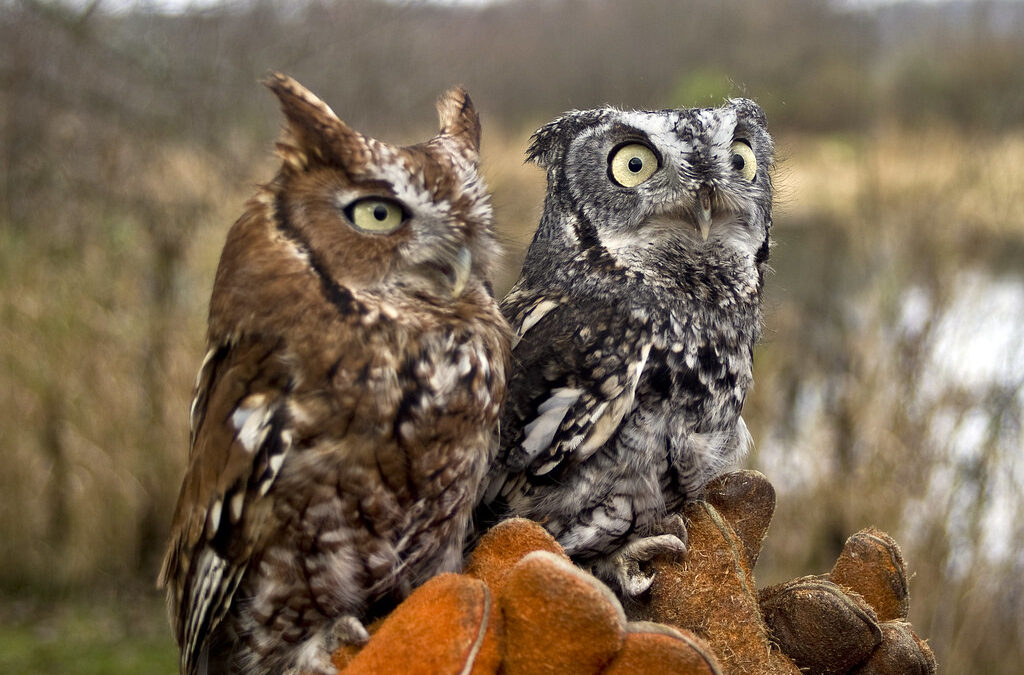By Emma Roth, Nature Educator
Last Sunday was the Chautauqua County Christmas Bird Count. At eight in the morning, six of us gathered at Audubon to see what birds we could find. This group consisted of myself and Leigh Rovegno, two people on the beginner’s side of the birding journey, and four fantastic birders that were doing the vast majority of the spotting and identification.
We had a good morning on the trails, counting a total of 34 species. Of those, the more advanced birders were excited by birds such as the Pine Siskin and Winter Wren. My favorite bird of the day, however, was one that I’m sure I’ve walked by dozens of times without noticing: the Eastern Screech Owl.

Eastern Screech Owls are relatively common, but highly elusive. They have fantastic camouflage and spend the daytime nestled in nooks or cavities of trees, blending in nearly perfectly, making spotting them a challenge. I have occasionally seen them with experienced birders who know how to call for them at night, and I’ve heard their long, trilling call during night hikes, and even from outside my window in Jamestown, but I had never seen one during the day.
Now, I will admit we cheated a little to see the one on Sunday. It was tucked away in a nest box on Audubon’s property—one that was designed specifically to attract screech owls. It was still a pleasant surprise when we opened it and saw the owl inside, angrily staring back at us as we had disturbed its peace. We took a minute to “”oooh and aaaah”” before closing the nest box and letting the owl get back to sleep.
Eastern Screech Owls are fierce predators. They spend the nights hunting small mammals like mice, moles, and voles, and have even been known to take on a squirrel or young rabbit. A single Eastern Screech Owl can eat as many as 1,000 mice in a single year. Along with mammals, they will hunt insects and small birds, such as starlings, chickadees, and sparrows. The owls will take the birds right from their nighttime perches as they sleep.

Since screech owls are strictly nocturnal, they rely on their large eyes, but also their incredible sense of hearing to hunt. They are able to locate prey easily in even the darkest forest nights. In fact, owls are one of the few birds of prey that can survive in the wild with eye injuries, as they can rely more on their sense of hearing to hunt than other birds of prey, such as hawks and eagles who rely solely on their vision.
While these owls are fierce predators, they are also incredibly adorable. They average between 6 and 10 inches tall and tend to weigh less than half a pound. Like most birds of prey, the males tend to be smaller than the females. When threatened, they will stand up straight and tall, making their prominent ear tufts as big as possible, to attempt to increase their size and intimidate potential threats.
Eastern Screech Owls are one of the more adaptable owls we have. They are comfortable in a wide range of habitats, as long as there are trees to hide in, including evergreen, deciduous, and mixed forests, as well as suburban and even urban environments. Of all the owl species we have, they are the most comfortable living in close proximity to humans, although they remain rarely seen.
While not a “rare” bird, seeing the screech owl was the highlight of my day. When I’m hiking, I often think about all the animals that are watching me as I obliviously walk past them. I’m sure many owls, racoons, coyotes, and foxes have silently watched me pass by. So, when I get the chance to see one of these elusive creatures, it’s a truly exciting event. While not rare to the world, they are certainly rare and special to me.
Audubon Community Nature Center builds and nurtures connections between people and nature. ACNC is located just east of Route 62 between Warren and Jamestown. The trails are open from dawn to dusk and birds of prey can be viewed anytime the trails are open. The Nature Center is open from 10:00 a.m. until 4:30 p.m. daily except Sunday when it opens at 1:00 p.m. More information can be found online at auduboncnc.org or by calling (716) 569-2345.


Recent Comments